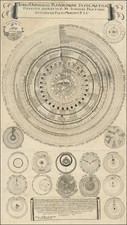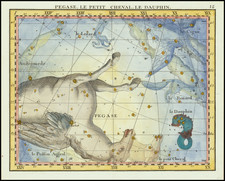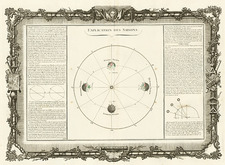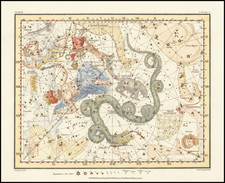Decorative pair of adjoining maps of the constellations, published by the Society for Diffusion of Useful Knowledge, represent the skies visible from December to May. They are carefully embellished with hand-colored constellations, including Leo, Virgo, Cancer, Gemini, Taurus, Orion, and the sprawling Hydra, which straddles both sheets, connecting them in a unique way, along with other constellations.
Leo, representing the lion, stands out with its prominent star, Regulus, identifiable due to its brightness. It's known for its association with royalty in various mythologies. Virgo, the second-largest constellation, symbolizing a maiden, is another significant figure in these maps, marked by its brightest star, Spica.
Cancer, smaller and less distinct, features the Beehive Cluster, one of the nearest open clusters to the Solar System. Gemini, representing the twins, has its two brightest stars, Castor and Pollux, marking the heads of the twins.
Taurus, known for its V-shaped cluster - the Hyades, harbors Aldebaran, its brightest star. Orion, arguably the most recognized constellation worldwide, is home to two of the brightest stars in the sky, Rigel and Betelgeuse, and features the famous Orion's Belt.
Hydra, the largest constellation, spans across both maps, with its head located near Cancer. Canes Venatici, relatively small, is known for hosting several galaxies and its brightest star, Cor Caroli. Leo Minor, a small and faint constellation, and Sextans, named after the astronomical sextant instrument, add to the celestial diversity.
The southern constellations, Crater, the cup, and Corvus, the crow, are associated with a legend of Apollo in Greek mythology. Coma Berenices, identified by its star cluster rather than a bright star, represents Berenice's hair in Greek myth.
Prominent constellations of the winter sky, Canis Major, home to Sirius, the brightest star in the night sky, and its smaller companion, Canis Minor, are also included. They are accompanied by Monoceros, a faint constellation nestled between them. Columba Noachi, also known as Noah’s Dove, is located nearby.
These maps not only feature constellations but also nebulae - the ‘nebuli,’ and stars of five different magnitudes. The varying magnitudes of the stars are represented by their size on the maps, giving a sense of depth and dimension to the otherwise two-dimensional representation.
In sum, these maps are an intersection of art and science. They serve as a guide for the amateur astronomer and a testament to our enduring fascination with the cosmos. They not only depict the grandeur of the celestial bodies but also narrate the stories they have inspired through the ages.














![[Aquarius]](https://storage.googleapis.com/raremaps/img/small/79552.jpg)